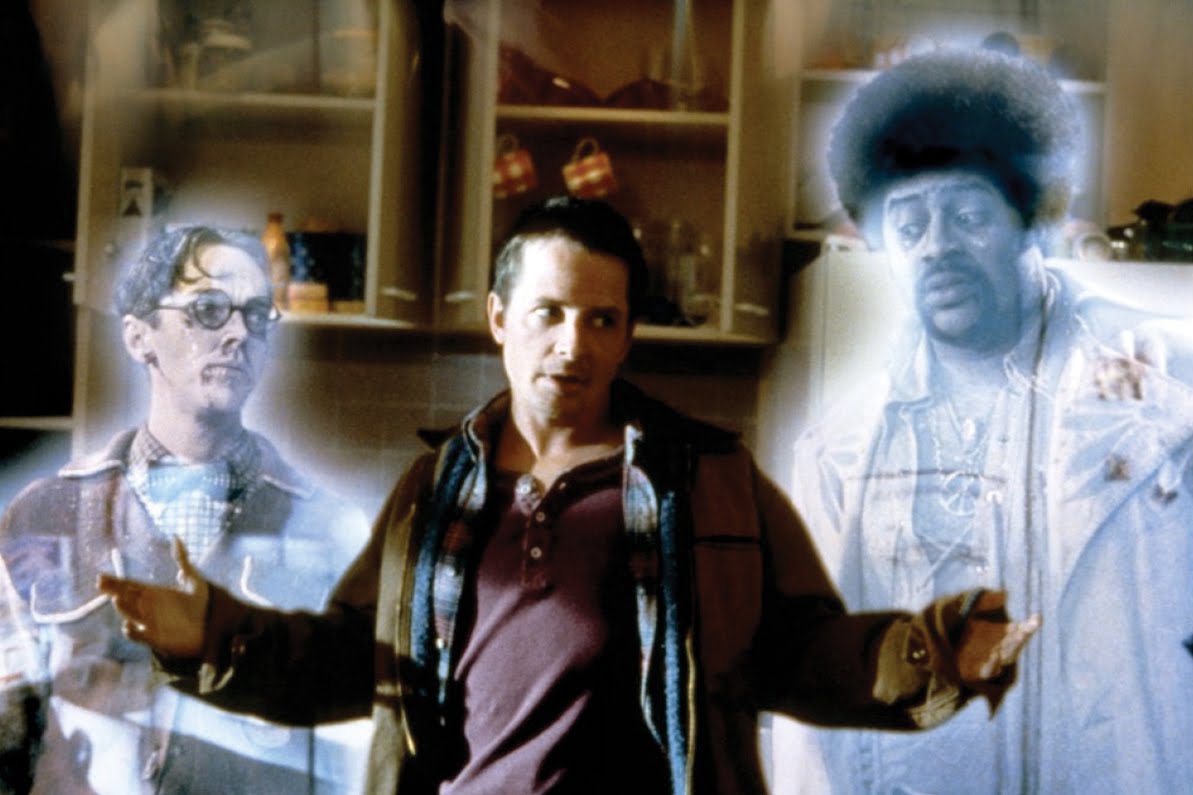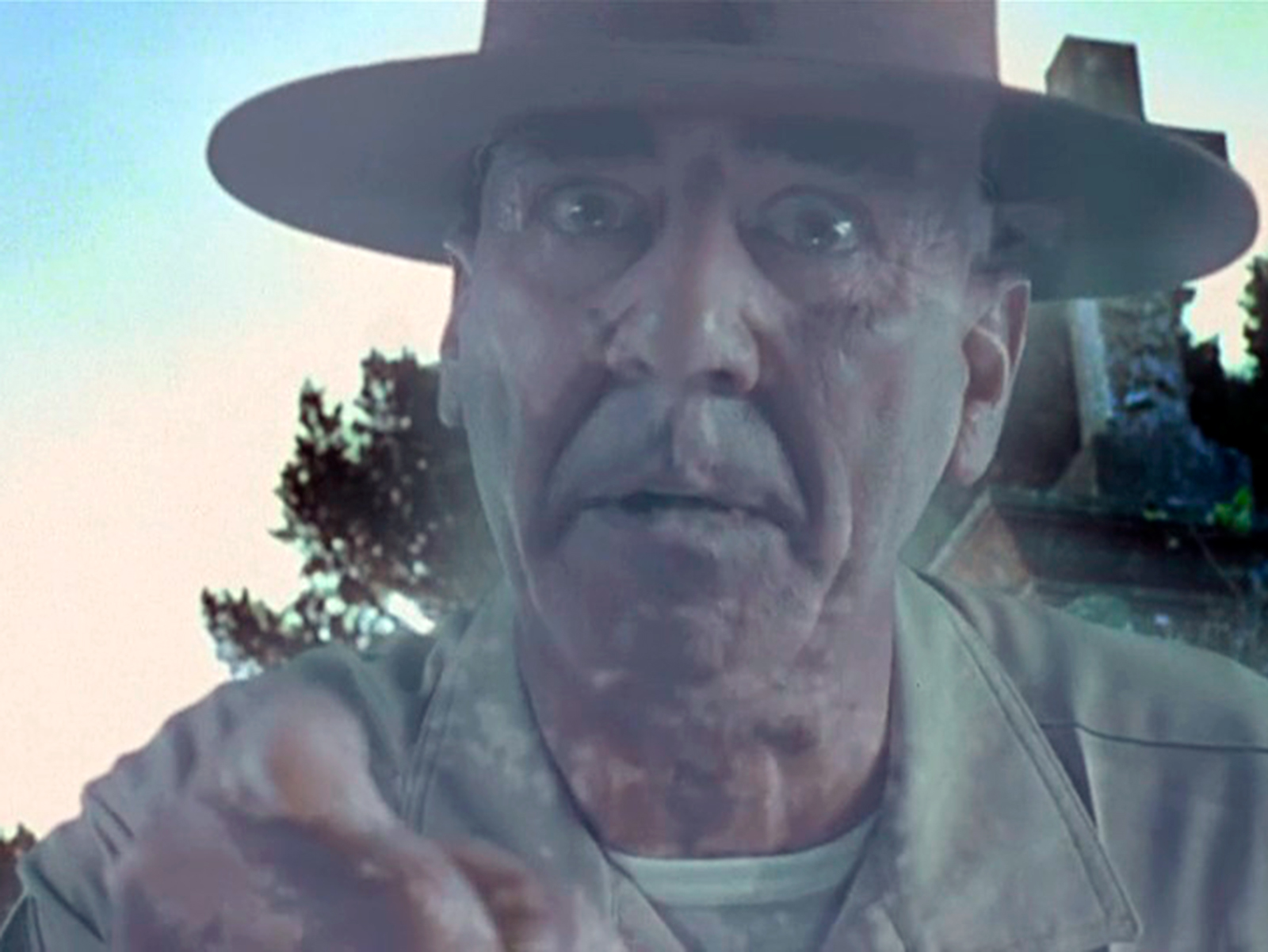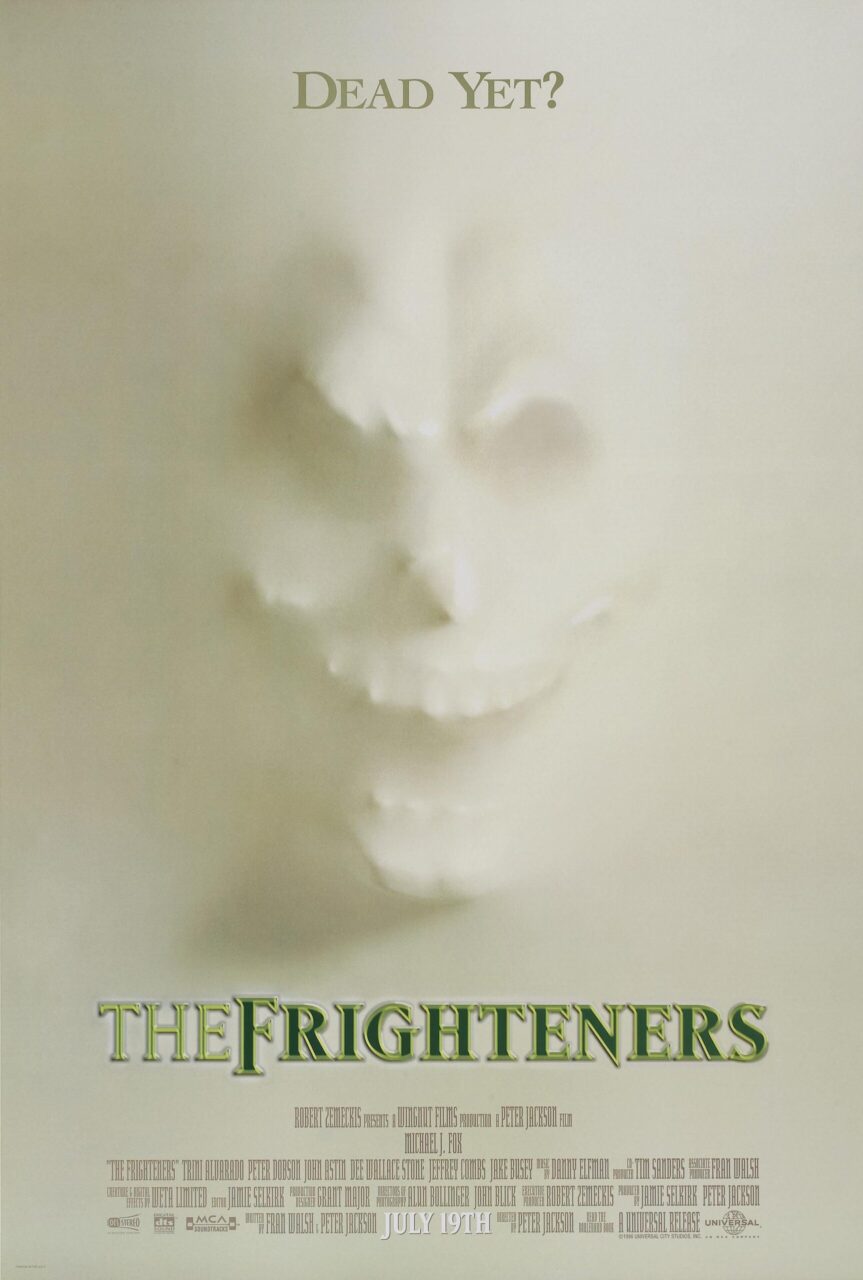USA/New Zealand. 1996.
Crew
Director – Peter Jackson, Screenplay – Peter Jackson & Fran Walsh, Producers – Peter Jackson & Jamie Selkirk, Photography – John Blick & Alun Bollinger, Music – Danny Elfman, Visual Effects – WETA (Supervisor – George Port), Creature Effects Supervisor – Richard Taylor, Judge Makeup Design – Rick Baker, Production Design – Grant Major. Production Company – Wingnut Films.
Cast
Michael J. Fox (Frank Bannister), Trini Alvarado (Dr Lucy Lynskey), Jeffrey Combs (Special Agent Milton Dammers), Dee Wallace Stone (Patricia Bradley), Peter Dobson (Ray Lynskey), Jake Busey (Johnny Bartlett), Troy Evans (Sheriff Walt Perry), Chi McBride (Cyrus), Jim Fyfe (Stuart), John Astin (The Judge), Elizabeth Hawthorne (Magda Rhys-Jones), R. Lee Ermey (Hiles), Julianna McCarthy (Lady Bradley)
Plot
Frank Bannister is a conman who runs a scam with the help of several ghosts, getting them to ‘haunt’ people’s houses and then Frank charging the owners a fee to ‘exorcise’ the house. The town is then struck by a spate of killings that appear to be being conducted by The Grim Reaper. In reality this is the ghost of a serial killer from the 1950s come to claim more victims and Frank is the only one capable of both seeing and stopping it.
I had always hoped that my debut in a major Hollywood motion picture would be one I could be proud of, one that I could take my grandchildren to and say, “Look, that’s me up there on screen.” So much for dreams – sadly to report The Frighteners is a disappointment. Oh, I am up there on the screen alright. So long as you don’t blink. Look for the shot where Michael J. Fox runs out of the newspaper office and is hit by a hearse. In the background of the shot there is someone running around the corner. A couple of seconds later you see from Michael J. Fox’s point-of-view the ghost of Peter Dobson coming toward the camera – just to the right of the people he runs through is someone shaking hands. That’s me and my five seconds of fame. Hi, mum.
The rest of The Frighteners is a big disappointment. Not that it couldn’t be considering the build-up the film had – at least in New Zealand. The film’s every move made national headlines during filming. Its’ first day of shooting made the headlines on both tv network news. The presence of Michael J. Fox – a star who had not had a big screen hit since the mid-1980s – was regarded as akin to a visit from royalty. Everything about the film made headlines – Michael J. Fox spending nights out at the Christchurch casino; Quentin Tarantino calling The Frighteners one of his favourite films of the year; even the sale of the house where several scenes were filmed. It is not that New Zealand had not had big-budget films shooting there before – Willow (1988), The Piano (1993) – but none of these were followed with the sense of excitement that The Frighteners was, the sense that we (the collective, national ‘we’) had landed the big one. Oh, there was the same sense of national jubilation when The Piano and Peter Jackson’s Heavenly Creatures (1994) won awards but that was only after they were made, there was no blow-by-blow account of every shot. [This would of course be superseded a few years later by the national mania that surrounded the making of Peter Jackson’s The Lord of the Rings trilogy].
How could the reality match a build-up comparable only to the Second Coming? And The Frighteners didn’t. In the USA, Universal never even considered the film worth a proper promotional campaign – it opened within a couple of weeks of the massive success of Independence Day (1996) and promptly did no business at all. Mainstream critics savaged the film – the problem being that they thought they had discovered Peter Jackson with Heavenly Creatures and when Jackson returned with a trademark Peter Jackson film they considered it a retrograde step rather than just Jackson making a typical Peter Jackson film.

When it comes to a certain type of film – the splatter comedy – Peter Jackson is a genius without equal. His first three films – Bad Taste (1988), Meet the Feebles (1990) and Braindead/Deadalive (1992) – are three of the funniest splatter films ever made. Who can ever forget Jackson’s pisstake of Platoon (1986) with Muppet frogs in Meet the Feebles or the Dali-esque splendour of the last 20 minutes of Braindead? Who else but a New Zealander could have come up with something as side-splitting as the sheep and rocket launcher gag in Bad Taste? Peter Jackson films, when they come down to it, are live-action Road Runner cartoons – Chuck Jones cartoons directed by someone with a gift for the kind of scatological, bodily-functions obsessed humour that seems the funniest thing in the world when you are fourteen years old.
I am probably the only person in New Zealand who found Peter Jackson’s critical breakthrough Heavenly Creatures a less interesting film than his splatter comedies. (For my money, the best of all Peter Jackson’s films up this point was his fake documentary Forgotten Silver (1995). I am not ashamed to admit it fooled me for about half its running time until I started to realise some its film references were fictitious). The true-life Parker-Hulme murder that Heavenly Creatures is based on is a story about girl-girl love and a friendship gone wrong. Maybe you could also argue it was about misguided creativity and the cloying conservatism of New Zealand in the 1950s. However, the least likely of things that it could be was a special effects film. Heavenly Creatures came out around the same time as two other lesbian killer films – Fun (1994) and Butterfly Kiss (1995). Both of these are disturbing films that contain startlingly good performances and powerful examinations of the psychology of the relationship. Heavenly Creatures on the other hand is a special effects film that jumps in at every opportunity with unicorns, claymation puppets and villainous Orson Welles-lookalikes. Put the other films alongside and in comparison Heavenly Creatures seems almost disinterested in the relationship, more interested only in the effects. Indeed, Peter Jackson quotedly said that the reason he made Heavenly Creatures was to test out the computer technology – which surely seems to have the point of making a film the wrong way around.
If you watch the documentary Good Taste Meets Bad Taste (1988) about the making of Bad Taste, you see startling affinities between Peter Jackson and Parker-Hulme. One senses what drew Peter Jackson to the Parker-Hulme case was not the story of the murder but an affinity to the girls’ creativity. The documentary shows Jackson, like Parker and Hulme, wrapped in a world of the imagination – they with their stories, he making Super-8 imitations of Ray Harryhausen films from the age of eight. Both Parker-Hulme and Jackson made Plasticine models and dreamed of making it in Hollywood.

What the documentary makes clear is that Peter Jackson’s real interest was more in special effects than ever in directing film. This is something abundantly clear in both Heavenly Creatures and The Frighteners. In The Frighteners, sadly the effects are the film. Period. There is nothing more to it than that. You keep looking for more. The film was billed as a horror comedy but there is none of the comic inspiration of Peter Jackson’s early films.
Compare The Frighteners to Beetlejuice (1988), an equally flawed film and one not too dissimilar to The Frighteners. With Beetlejuice you come away remembering its moments of visual inspiration – the dinnertable scene with the shrimp cocktails coming up to possess the diners for a rendition of Day-O or the afterlife social services room filled with tyre-marked hit-and-run victims and chain-smoking corpses insisting they are trying to cut down – and wishing it had been supported by a plot. With The Frighteners you come away without anything lingering in the memory and still wishing it had been supported by a plot. Perhaps the nearest The Frighteners comes to inspired humour is R. Lee Ermey doing a parody of his drill sergeant from Full Metal Jacket (1987). The rest of the film vanishes into a blur of spinning camera moves. The one other thing one remembers – although only out of its sheer awfulness – is an astonishingly over-the-top performance from Jeffrey Combs, which contains some of the most out of control acting one has seen in any film.
The Frighteners is incredibly busy racing from one incident to the next as the camera spins with a giddiness. You come away from the film with the feeling of having been on a rollercoaster ride but the more you think about the film afterwards the more you wish there had been something to support such busyness. Take the plot – you come away with all sorts of unanswered questions. What was it that caused Michael J. Fox, the earnest and caring architect we see in flashback, to turn into a cynical conman? There is such a gulf between these two aspects of the character it is hard to believe they are the same person. What made Jeffrey Combs’s FBI agent so obsessed? How did Michael J. Fox manage to rope the ghosts into helping him in his congame?

There is an interesting dichotomy the film makes between its ecumenically neutral vision of the afterlife and the sudden appearance of a scythe-wielding Mediaeval Grim Reaper but Jackson and co-writer/real-life partner Fran Walsh throw such speculation away in about one line and then rush off again. For a fantastic film, such a dichotomy and its revelation that the Grim Reaper is a disguised spirit needs to be one of the dramatic highlights of the film. Even this revelation fails to make sense. Why does the killer bother to pose as the Grim Reaper when only people who have had a particular type of shock (surely under 0.00001% of the population) can see him? Not even the killer’s victims can see him so what is the point of the disguise?
If The Frighteners had slowed down for about five minutes to answer such questions it might have been a more interesting film. You would actually get the feeling that Peter Jackson cared about something more than effects and hurtling pace. However, all that you feel in The Frighteners is that everything has been crammed together indifferent to whether it makes sense, indifferent to anything other than effect.
The Frighteners was originally pitched by Peter Jackson and Fran Walsh as an entry in the series of Tales from the Crypt film begun with Tales from the Crypt Presents Demon Knight (1995), although Tales from the Crypt producer Robert Zemeckis was sufficiently impressed with Heavenly Creatures to come aboard and back The Frighteners as an original production. The film’s failure at the box-office helped to sink Peter Jackson’s next planned King Kong remake at Universal, but he then recovered and climbed to extraordinary heights with the massive success of the Lord of the Rings trilogy, The Lord of the Rings: The Fellowship of the Ring (2001), The Lord of the Rings: The Two Towers (2002) and The Lord of the Rings: The Return of the King (2003). Jackson later went on to conduct his remake of King Kong (2005) and followed this with The Lovely Bones (2009), The Hobbit: An Unexpected Journey (2012), The Hobbit: The Desolation of Smaug (2013) and The Hobbit: The Battle of the Five Armies (2014). Jackson has also produced District 9 (2009), The Adventures of Tintin (2011), Mortal Engines (2018) and The Lord of the Rings: The War of the Rohirrim (2024).
Trailer here


